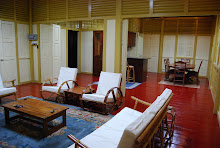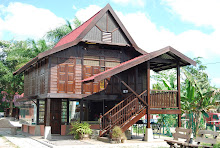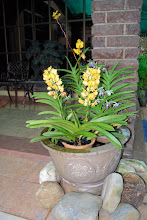
Wednesday, December 31, 2008
THE 11th YANG DI PERTUAN BESAR OF NEGERI SEMBILAN

Sunday, December 28, 2008
PANTANG TOK NENEK (DISLIKES OF GENERATION)
Thursday, December 25, 2008
A NEW BEGINNING
 A sign that a new year is just across the line with this tree flowering its yellow blooms. It also heralds that the dry season or 'musim timor' is back in the Kedah plain. We will enjoy cool days and nights and time to start flying the kites too.
A sign that a new year is just across the line with this tree flowering its yellow blooms. It also heralds that the dry season or 'musim timor' is back in the Kedah plain. We will enjoy cool days and nights and time to start flying the kites too.Thursday, December 18, 2008
WHAT DO WE DO AT HOME?
It’s a Friday morning and a weekend and a continuing day in the month of Ramadan, most people in Kedah would likely be lingering snugly in their homes happily knowing that they do not have to rush to office or work. Those who normally go marketing on weekend would likely delay till later in the afternoon: a departure from the normal weekend outside Ramadan. The housewives deserved a good rest having served the household during the weekdays with all manner of dishes and concoctions, tempting the appetites for those breaking fast when the sun hits the horizon and the muezzin calls the followers to prayer.
I am dragged into slumber too. Yet in such moments, you seemed to fathom issues. Foremost I begin to seek answers to an equally simple query. What task do we performed at home? What is its scale in relation to other activities? I am inclined to believe that more contributions by male folks are due and forthcoming. Maybe I am stepping on thin ice. Six decades of living cannot be a better reason to justify this observation. Do women work more or ‘harder’ at home than men?
I am not suggesting that men have to slog and do all the house-works. The question is “What do they really do when they are at home or don’t do? Do their duties measure equally with that delivered by their other halves?
The old adage that women stayed at home and the male went to work is dead and gone. Now husbands and wives fulfilled their obligations as career persons, leave and return homes almost simultaneously. Observably the ladies of the home change into another role almost immediately upon reaching home as housewives. Husbands: they change their garbs mostly to exercise, offer their prayers or relax; waited to be served with hot cups of coffee and maybe some delicacies that were bought on the way home. Would they leave their sofas and moved into the garden, water the plants or got hold of the hose to wash the cars? Your answer is as good as mine. The wives would be fortunate if they had helpers at home otherwise they would have to turn their attentions to the children, their needs and urgencies too. A chance to turn on the TV and hear the news broadcast at six? Not likely. Even to attend to prayers would be a matter of urgency.
It is an after thought that the equal or unequal sharing of responsibilities needed a look in. We notice that the women have a greater or heavier burden of responsibilities or duties. ( who impose them in the first place?) They seemed to have abundance energy diving into the roles of motherhood and wives etc, ready to serve the needs of the family.
Where do we start to weigh these sharing responsibilities? Could it be at the primary or secondary level education? At home itself, when children learn directly from their parents? Or wait for lessons to be included in the compulsory marriage courses (right now for Muslims only)
Yet with all that endurance and iron – women reflections, the tender genders have longer or prolonged lives and able to bear the consequences for what may come in the pipelines. Or would there be resistance as already seen in other countries when marriage becomes hard to come by?
(This is a point noted during one day in the last fasting month. Possibly my point of attention was directed at one particular sector and yet I remained to be corrected if it is untrue, biased or inconcrete)
Monday, December 8, 2008
HAJ 1429 (2008) 10 ZULHIJAH/ 08 DECEMBER

As they stepped out with their right feet from the home attended by prayers from those who loved them just as many before them have done before.
Saturday, December 6, 2008
TOP SIX SMALL ASIAN CITIES/ ASIAN CITIES OF THE FUTURE
An fDi report recently accorded ALOR STAR, this city in KOTA STAR KEDAH in the following term:
" Of Asia's major cities, Tokyo scores top for infrastructures, while Melbourne comes out top for quality of life. Alor Star the state capital of Kedah in Malaysia is fDi's small Asian City of the Future, scoring well across several categories, including economic potential, cost effectiveness and business friendliness."
Now with such a laurel, what are we waiting for. Now that the city tops even others in the counting such as Newcastle ( Australia), Jeju City ( South Korea). Taoyuan City ( Taiwan) and Ipswich(Australia) over many categories too, it can be a big reward and even a major investment if it need be. But do we (State Government, Officials, Industrialist and Business people) are awake to this declaration? It is all quiet in the northern front except for a small extract in Utusan Malaysia, the Malay Newspaper recently. Given such an advantage and honor, Dato Bandar ( Lord Mayor) especially would grasp the opportunity and together with the tourist development authority bring about greater participation and increased flow of tourist and visitors into the state and city especially. Maybe it needs a wakeup call.
The report is available: http://www.fdimagazine.com/news/fullstory.php/aid/2228/Asian_Cities_of_the_future_2007_08 html
Thursday, December 4, 2008
REDISCOVERING LAHUMA OF RSJ
It would not be safe to take them to the fast flowing Baling River and with the water quite coffee-colored after a heavy downpour the previous night. So the stream was suggested. It was a marvelous suggestion as we found the place extraordinarily peaceful, tempting and delightful for the children as well as anybody who have been in the maddening cities for sometimes. The cool, light forested corner with gentle flowing mountain stream dashing against pebbles and sand that have barricaded one piece of its bank is indeed a good respite for the juniors and seniors alike. Not likely to impress anybody with descriptions however flowery and imaginative it may be, what excellent way is to take a look at the photos accompanying. I am assured you will be tempted to seek similar corners if possible. I came home with a basketful of polished eroded pebbles fit for the fish aquariums too among other things.
 It is fortunate that such corners of serenity are still available
It is fortunate that such corners of serenity are still available The young brother and his sister having the best time frolicking in the mountain stream. Notice the pebbles strown on the side.
The young brother and his sister having the best time frolicking in the mountain stream. Notice the pebbles strown on the side.
It was not the delightful spot that really struck me so much, but the peripheral activities just close by which invariably I perceived escaped the attention of many including those who came regularly to share the splendor that was there.
Remember Shahnon Ahmad and you will of course linked him to one of his great novels namely ‘Ranjau Sepanjang Jalan’ translated it meant “No Harvest but A Torn” It was to be my close apprehension of Lahuma.
Today perhaps I came face to face with ‘Lahuma’. The elderly person tending to his small plot of land was busy moving around doing the necessaries, aided by his wife and relatives. His plot of hill padi was ready for harvesting and he had to reap them as fast as possible. Already, just as Lahuma had dreaded, the small tiny birds have come in groves, chirping away and their resonance echoed in the quite afternoon sun. Any man would panic. Our man Pak Daud by name was in no rush but tended as calmly as possible.
I quote abstracts from the novel Ranjau Sepanjang Jalan:
“Lahuma dijemput menghadapi ILAHI”
“Hidup mesti diteruskan. Tugas Lahuma perlu dipikul oleh Jeha dan anak-anaknya. Mereka tidak harus mati kelaparan, sawah padi perlu menguning. Hujan lebat, banjir besar dan kedatangan ketam serta burung tiak yang menjahanamkan padi perlu ditentang.
Berbekalkan doa dan usaha, mereka tekad – tiada apa yang dapat menghalang perjalanan hidup ini”
I knew Pak Daud was as cautious as possible. He had ascertained the birds ‘burung tiak’ were eliminated as far as possible. But these little creatures can come in squadrons and make light works of the rice stalks. Pak Daud held a pair of the small creatures in his hand, cursing them for continuing to invade his plot although he has taken the necessary steps. So these were the tiny crop destroyers. Just like the grasshoppers, ‘burung tiak’ are just as vociferous. He offered the little creatures if I cared to keep them. They are small. The one he held was the size of Pak Daud’s thumb but in numbers they are disastrous. Still the crabs have not been taken into account yet.
He and his family went about harvesting the crop in the traditional ways and hopefully pray that all would go well. In their moments of exuberance, they ascertained that they would reap a gainful harvest; thankful that they had worked hard. Unlike Lahuma, Pak Daud was still the core member of his family. I looked at him, a man who must have crossed seventy years plus, maybe nearing eighty but still agile, strong and focused at making the best of his toils. No not many would be that exemplary as shown by many hillside plots in the neighborhood left vacant, unattended and overgrown with ‘lalang’ and bushes.
They had built a frail hut on the plot of land, temporarily giving them shelter day or night if necessary. Perhaps the main tarmac road, supply of electricity and closeness to the neighbors and the ‘cherok’ added to give some comfort and security. Lahuma and Jeha of Banggol Derdap in the district of Sik, no more than an hour drive from this village, had no such luxuries forty years ago when Shahnon wrote his novel.
I am thankful that either ordained or by chance I had the opportunity to come across a live situation much discussed by Shahnon Ahmad in his epic novel, read, discussed even crucified at secondary, college and tertiary levels. That it has been made into a film ‘Rice People’ produced in Cambodia in 1994, directed and co-written by Rithy Panh speaks highly of the intrinsic value of the peasants and their livelihood. (The film premiered in the main competition at the 1994 Cannes Film Festival and was submitted to the 67th Academy Award, the first time a Cambodian film had been submitted as a possible nominee for Best Foreign Language Film) See https//en.wikipedia.org/wiki/Rice_People
I have read ‘Ranjau Sepanjang Jalan’ before; imagined the hardship and landscape as described by Shahnon but sincerely have not seen its true self. Today I did even though at a neighboring kampong site and thankful for understanding all that are worth. Maybe the children’s thrill and frolicking in the mountain stream put off what would have been a much deeper recollection of time past when hardship knocked on most peoples’ doors irrespective where they were.
3 December 2008

 "Lahuma tending to his small plot of 'hill padi' which has taken six months to give him the substance"
"Lahuma tending to his small plot of 'hill padi' which has taken six months to give him the substance"
 Notice the special traditional instrument used to reap the rice stalk. This is the 'ketam padi'
Notice the special traditional instrument used to reap the rice stalk. This is the 'ketam padi' He is a happy man. Thankful that his hard work has given him the wealth of hard toiling and the richness of the earth
He is a happy man. Thankful that his hard work has given him the wealth of hard toiling and the richness of the earth

Tiny tots but the plague of the farmers especially when they come in squadrons










